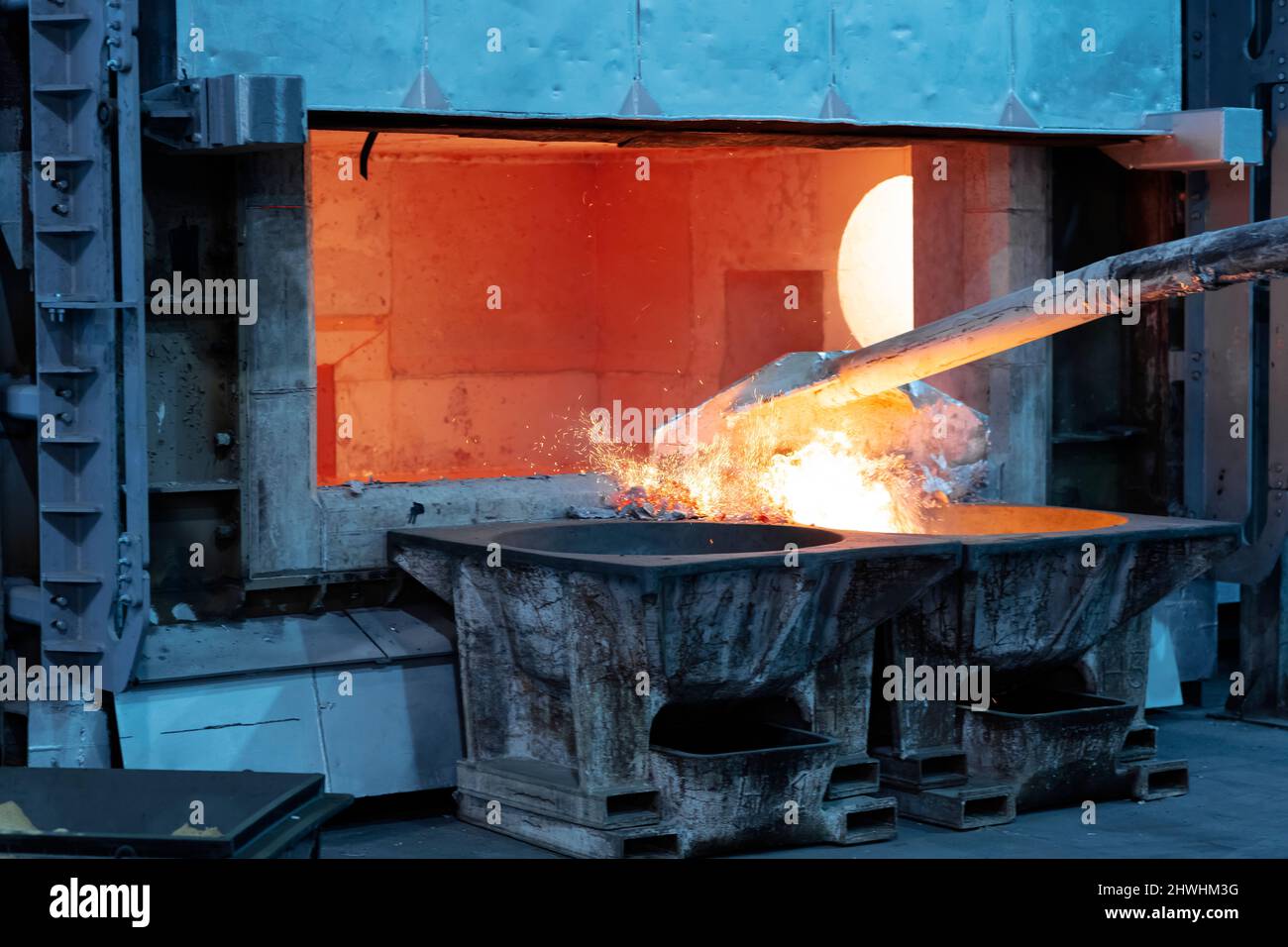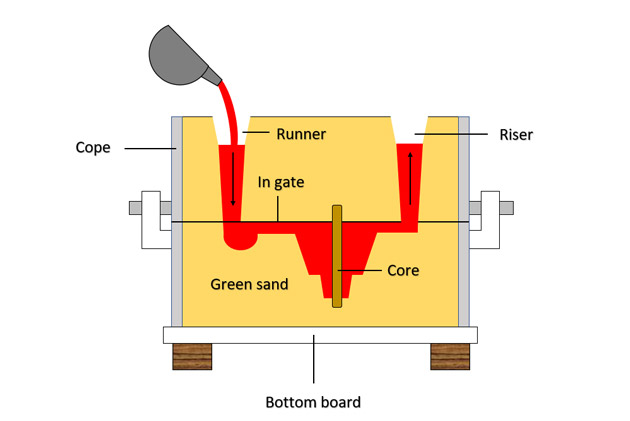Just How Aluminum Foundry Contributes to Advancements in Aerospace Design
Aluminum foundries are integral to improvements in aerospace engineering. They create lightweight, high-strength parts that are vital for modern airplane. Through innovative casting strategies, these factories develop complicated geometries that improve architectural integrity. In addition, the development of remarkable Aluminum alloys sustains the industry's concentrate on gas performance and sustainability. Obstacles stay in the production procedure. Understanding these aspects discloses the profound impact of Aluminum on air travel's future.
The Value of Lightweight Products in Aerospace Design
As the aerospace market continues to advance, the importance of lightweight materials ends up being significantly evident. The demand for efficiency and sustainability drives engineers to prioritize making use of materials that minimize general weight without endangering architectural honesty. Light-weight products, specifically Aluminum, play a vital function in improving gas performance, boosting haul ability, and increasing the general efficiency of aircraft.
The combination of these materials allows for innovative designs, enabling suppliers to develop even more aerodynamic shapes that can stand up to severe problems. The decrease in weight not only reduces operational costs yet likewise adds to a decreased ecological footprint, aligning with international initiatives towards sustainability in air travel.
Advanced Casting Techniques in Aluminum Foundries
Advanced spreading methods in Aluminum factories play a critical duty in aerospace design by enabling the manufacturing of light-weight and accurate elements. Technologies in mold and mildew layout and precision casting procedures are vital in achieving excellent efficiency and architectural stability. Furthermore, the growth of lightweight alloys improves the overall performance and efficiency of aerospace applications.
Cutting-edge Mold Layout
Ingenious mold and mildew design plays an essential function in the performance and efficiency of Aluminum foundries, especially within the aerospace sector. By leveraging innovative materials and strategies, modern molds can be crafted to stand up to high temperatures and stress, making certain peak efficiency during the casting process. These designs commonly incorporate complicated geometries that permit the manufacturing of lightweight yet structurally audio elements, essential for aerospace applications. Furthermore, the use of computer-aided style (CAD) software application promotes accurate modeling, allowing shops to simulate and fine-tune mold styles prior to physical manufacturing begins. This not only boosts the high quality of cast parts however additionally decreases waste and preparation, resulting in considerable price savings. Generally, innovative mold and mildew layout is a keystone of development in Aluminum Foundry innovation for aerospace design.
Precision Casting Procedures
The performance of ingenious mold and mildew styles flawlessly integrates with accuracy casting procedures, which are essential for generating high-grade Aluminum parts in aerospace engineering. These procedures, including sand spreading, die spreading, and investment spreading, assure the creation of intricate geometries with limited tolerances. Advanced methods like vacuum spreading and stress die casting improve the honesty and surface area coating of the end products. Accuracy casting decreases product waste while making the most of the mechanical buildings of Aluminum, critical for aerospace applications. In addition, employing real-time surveillance and advanced simulation tools throughout the casting process enables for instant modifications, resulting in boosted top quality control. Collectively, these accuracy casting procedures placement Aluminum foundries at the forefront of aerospace technology, supporting the industry's demand for reliability and efficiency.
Light-weight Alloy Development
As aerospace designers look for to enhance gas effectiveness and performance, lightweight alloy growth ends up being an important emphasis in Aluminum foundries. These shops use advanced spreading strategies to create alloys that provide exceptional strength-to-weight proportions. Advancements in alloy structure, consisting of the incorporation of aspects like lithium and magnesium, enable the manufacturing of products that withstand severe problems while decreasing total aircraft weight. Techniques such as die spreading and investment spreading help with the accuracy production of intricate shapes, which are crucial for aerospace applications. Furthermore, ongoing study aims to optimize these alloys for enhanced mechanical residential or commercial properties and enhanced toughness. By prioritizing lightweight alloy development, Aluminum foundries significantly add to the advancement of aerospace design, leading the way for much more lasting and reliable airplane designs.

Enhancing Architectural Integrity Through Aluminum Parts
Aluminum elements use considerable benefits in improving architectural stability within aerospace engineering. Their lightweight nature contributes to overall efficiency while maintaining toughness, which is essential for aircraft efficiency. In addition, the stress and anxiety resistance residential properties of Aluminum assistance guarantee the resilience and integrity of aerospace structures under various functional problems.
Lightweight Material Advantages
While conventional materials typically endanger weight for strength, making use of Aluminum parts in aerospace engineering supplies significant benefits in structural honesty. Aluminum's light-weight nature contributes to overall design performance, enabling more streamlined airplane that take in less fuel, thus boosting sustainability. The product's excellent strength-to-weight ratio guarantees that components maintain longevity without including unneeded mass. This go now quality promotes improved performance and dexterity in flight, as well as optimized haul abilities. Furthermore, Aluminum's resistance to deterioration extends the life expectancy of aerospace frameworks, reducing upkeep costs browse around this web-site and boosting safety and security. As manufacturers progressively adopt Aluminum alloys, the aerospace sector experiences a transformative shift towards much more efficient and reliable design solutions that prioritize both performance and ecological obligation.
Anxiety Resistance Characteristics
Although various products possess special residential or commercial properties, Aluminum's outstanding stress resistance sticks out as a critical consider improving the architectural integrity of aerospace elements. This resistance plays a crucial role in guaranteeing that aircraft can endure various operational stresses, consisting of exhaustion, influence, and ecological conditions. Aluminum alloys, particularly engineered for aerospace applications, exhibit high tensile strength while maintaining light-weight attributes, allowing engineers to make a lot more efficient structures - Aluminum Foundry. Furthermore, the capability of Aluminum to endure cyclic loading without significant contortion adds to the durability and reliability of aerospace components. As innovations proceed in Aluminum Foundry techniques, the development of stress-resistant Aluminum parts guarantees further renovations in efficiency, safety, and performance throughout the aerospace industry, strengthening Aluminum's function as a favored material in modern-day engineering
Fuel Performance Improvements Driven by Aluminum Innovations
As the aerospace market seeks to boost fuel performance, ingenious uses Aluminum have actually become a crucial option. Aluminum's lightweight nature especially decreases airplane weight, enabling for lower gas usage throughout flight. This decrease in weight is important, as also little declines can result in significant improvements in total fuel economy.
Advanced Aluminum alloys, made for improved toughness and toughness, enable makers to create elements that keep architectural stability while decreasing mass - Aluminum Foundry. Additionally, the assimilation of Aluminum in airframes and engine components helps with improved the rules of aerodynamics, adding to reduced drag and boosted efficiency
The adoption of Aluminum in aerospace not only fulfills the demand for fuel-efficient style yet also lines up with governing stress for lower exhausts. As these developments remain to evolve, they play a considerable duty in establishing new standards for gas performance, making certain that the aerospace market can meet growing financial and environmental challenges.

The Role of Aluminum in Sustainable Aviation Practices
The increasing emphasis on lasting air travel practices has positioned Aluminum as an essential material in the quest for greener aircraft layout. Known for its lightweight residential or commercial properties, Aluminum considerably lowers airplane weight, bring about reduced gas intake and discharges. Its recyclability additionally improves its sustainability profile, as Aluminum can be reused forever without loss of high quality. This particular sustains a circular economic climate within the aviation field, lessening waste and resource depletion.
Developments in Aluminum alloys have boosted their stamina and corrosion resistance, permitting for longer service life and reduced upkeep needs. These technologies assist in the development of extra effective airplane structures, adding to total sustainability efforts. Furthermore, Aluminum's thermal conductivity plays an important duty in energy-efficient styles, enhancing systems such as warmth exchangers. Collectively, these attributes emphasize Aluminum's critical duty in advancing lasting visit homepage aviation, lining up with worldwide campaigns focused on reducing the ecological influence of air travel.
Obstacles Faced by Aluminum Foundries in Aerospace Production
While Aluminum foundries play a necessary role in aerospace production, they deal with substantial challenges that can affect manufacturing efficiency and high quality. One major challenge is the rigid top quality control requirements needed in the aerospace sector. Any kind of defect can jeopardize security and performance, demanding rigorous assessment processes that extend production timelines. Additionally, shops frequently compete with rising and fall resources costs, which can affect prices and productivity. The intricacy of Aluminum alloys made use of in aerospace applications more makes complex the production procedure, as specific solutions are crucial for achieving desired mechanical properties. Furthermore, competent labor shortages impede the capability to keep high-grade production degrees. Environmental policies enforce restrictions on emissions and waste monitoring, needing factories to invest in lasting practices, which can be cost-prohibitive. These factors collectively create a landscape where Aluminum shops have to continually adapt to fulfill the evolving needs of aerospace production while making certain safety and security and conformity.
Future Trends in Aluminum Applications for Aerospace Design
With improvements in innovation and raising demands for effectiveness, the future of Aluminum applications in aerospace engineering is positioned for considerable transformation. The combination of innovative Aluminum alloys and compounds is expected to enhance strength-to-weight proportions, resulting in even more fuel-efficient aircraft styles. Furthermore, improvements in additive manufacturing strategies will permit for the production of complicated Aluminum frameworks that were previously difficult, optimizing efficiency and reducing waste.

Sustainable methods will certainly play an essential role, with a growing emphasis on recycling Aluminum to minimize environmental impact. The aerospace market is most likely to accept smarter producing processes, such as automation and expert system, making sure better and accuracy in Aluminum parts. Collaborations between Aluminum foundries and aerospace firms will foster research and development, paving the method for new applications that meet the stringent requirements of modern aerospace design. On the whole, the future looks assuring for Aluminum's function in shaping the skies
Often Asked Concerns
What Are the Environmental Impacts of Aluminum Manufacturing in Aerospace?
The ecological effects of Aluminum production in aerospace consist of substantial energy consumption, greenhouse gas emissions, and environment disruption. Furthermore, mining processes can bring about dirt degradation and water contamination, raising problems regarding sustainability and ecological equilibrium.
Just How Does Aluminum Compare to Various Other Products in Aerospace Applications?
Aluminum provides an one-of-a-kind combination of lightweight buildings, corrosion resistance, and cost-effectiveness compared to various other materials. Its high strength-to-weight ratio makes it specifically beneficial for aerospace applications, boosting fuel performance and general efficiency in aircraft style.
What Qualifications Do Aluminum Foundry Employees Need for Aerospace Projects?
Aluminum Foundry employees require specific training in metallurgy and spreading methods, together with understanding of aerospace sector standards. Qualifications in quality assurance and safety and security protocols are likewise important to assure compliance with rigid aerospace project demands.
Exist Any Security Interest In Using Aluminum in Aerospace Engineering?
Safety worries concerning Aluminum in aerospace design include susceptibility to fatigue, tension, and deterioration cracks. Proper treatment and alloy selection are important to alleviate these threats, ensuring architectural honesty and general security in aerospace applications.
Exactly How Does Aluminum Recycling Advantage the Aerospace Sector?
Aluminum reusing greatly benefits the aerospace market by minimizing product prices, minimizing ecological influence, and preserving power. This sustainable method enhances the sector's efficiency while promoting making use of lightweight, high-performance components in aircraft manufacturing.
Advanced casting strategies in Aluminum foundries play a critical role in aerospace design by allowing the manufacturing of exact and light-weight components. Ingenious mold design plays a crucial role in the efficiency and performance of Aluminum foundries, especially within the aerospace industry. As aerospace engineers look for to improve fuel efficiency and efficiency, lightweight alloy growth ends up being a necessary focus in Aluminum factories. Aluminum alloys, specifically crafted for aerospace applications, show high tensile strength while keeping light-weight features, allowing engineers to design extra effective frameworks. Partnerships between Aluminum shops and aerospace firms will promote research and growth, paving the method for brand-new applications that satisfy the stringent demands of modern aerospace design.